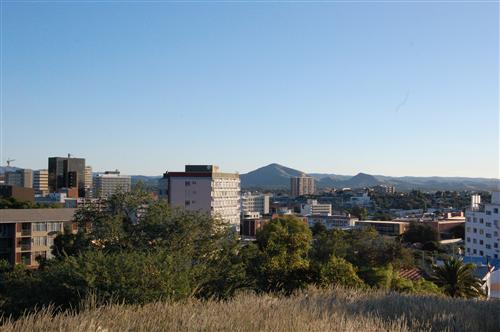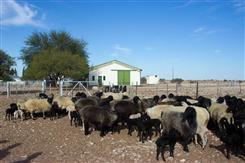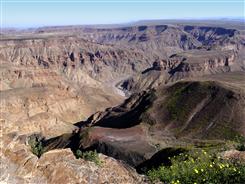Basic Data
Namibia is located on the south west coast of Africa, north of South Africa and bordering the Atlantic Ocean. A riparian country to the Cunene (Kunene), Cuvelai, Okavango, Zambezi and Orange-Senqu River basins, Namibia has the second-lowest population density in the world at 2,61 people per km². The estimated population of 2 148 000 (2011) is distributed across an area of 824 116 km². Most of the population is of Ovambo ethnicity; there are also Herero and Himba people and large groups of Khoisan speaking people (e.g. Nama, San and Damara). The remainder includes people of mixed race, called "Coloureds" and "Basters", and Whites.
The capital city of Namibia is Windhoek, located near the geographic centre of the country. The population growth rate is estimated at 1,7% (2011), Namibia’s population is very young with a median age of 21,7 years in 2011. As throughout southern Africa, the HIV/AIDS epidemic in Namibia is severe, but considerably less severe than in the other countries of the basin. In 2009 the adult prevalence rate was 13,1%. The Human Development Index (HDI) for Namibia is 0,625 (2011), ranking it 120th out of 187 countries with data (UNDP HDR 2011).

The Windhoek skyline.
Source:Hatfield 2008
( click to enlarge )
Challenges for development
The Namibian economy rests on four pillars: mining, agriculture, fishery and tourism.
Namibia is one of the largest exporters of uranium in the world and one of the largest diamond producers in the world; however, the uranium production is not within the Orange-Senqu River basin and the diamond mining activities are either small-scale artisanal alluvial operations along the river or on a larger scale at the lower Orange and along the coast to the north of the Orange River Mouth. Other available natural resources include various heavy and precious metals with suspected off shore oil deposits. Although the mining sector only employs 3% of the population and accounts for 8% of the GDP, it provides more than 50% of the foreign exchange earnings. This sector on the one hand provides Namibia with financial resources for development, on the other hand it heavily contributes to the fact that Namibia is the country with the most unequal income distribution in the world.
The majority of Namibians (64% of the rural population) are subsistence farmers susceptible to food shortages during times of drought. Most subsistence farming occurs in the northern areas of the country and is concentrated on food crops with livestock produced for local consumption. Commercial agriculture is dominated by livestock ranching in the southern and central regions. In the south of Namibia, farming is mostly small stock with some irrigation areas (Hardap Irrigation Scheme, Stampriet, Naute and the Orange River). A new dam and associated irrigation infrastructure at Neckartal on the Fish River, near Seeheim, are currently under construction. Irrigation is being created along the Orange River to support the production of table grapes and dates for the European and American markets. Export of table grapes creates several thousand seasonal jobs and represents a comparative advantage for Namibia, as the grapes become available on the market 2–3 weeks before South African grapes.
Prolonged droughts, retrenchment of farm workers due to modernisation and poor socio-economic conditions in rural areas in general have motivated many working age Namibians to migrate to the cities, especially Windhoek. Urban job opportunities, however have not always met the aspirations of those seeking better living conditions there, resulting in the growth of informal settlements with a lot of social tensions. About half of the country’s working age population is currently unemployed; the majority of employment comes from unskilled, informal labour, with mining and services contributing in a minor way to the overall total employment in the region.
Namibia’s fishing industry developed quite well in 2003-2007, when it accounted for a lot of foreign exchange income. Since 2007, however, the fisheries industry has been challenged by decreasing yields.
Tourism is Namibia’s third biggest foreign exchange earner). Namibia’s Lower Orange River basin offers an opportunity to develop eco-tourism focusing on the unique biodiversity here (Ai-Ais and Sperrgebiet National Parks). The Fish River Canyon is an outstandingly attractive tourist destination in the Orange-Senqu River basin
 Karakul farming. Source:DRFN 2008 ( click to enlarge ) |
 Fish River Canyon. Source:DRFN 2008 ( click to enlarge ) |
Efforts to Reduce Poverty
Poverty is widespread in Namibia, and the country exhibits an extremely uneven distribution of income, with the wealthiest 5% of the population controlling 70% of the GDP. In 2005 34,9% of the population lived on less than one US-Dollar per day, 55,8% on less than two dollars a day (www.indexmundi.com ); these were mainly subsistence farmers and hunter-gatherers in rural areas.
Namibia’s Poverty Reduction Strategy focuses on three areas that are considered key to progress in poverty reduction (NPC 1998):
-
How to foster more equitable and efficient delivery of public services (in the context of Namibia’s commitment to regional decentralisation) for poverty reduction countrywide
-
How to accelerate equitable agricultural expansion, including consideration of food security and other crop development options
-
Options for non-agricultural economic empowerment, including an emphasis on the informal sector and self-employment options
A World Bank Report (2009) recommends increased use of labour (the most important asset of the poor) and changes in regulations related to labour absorption, small businesses and market codes. As mentioned in the Poverty Reduction Strategy (PRS), public services, goods and infrastructure are key, as well as better access to health care, education, agricultural services and transport. Including women in all aspects of the strategy is essential, as they are the most marginalised.
One poverty-alleviation initiative that is proving successful is Community Based Natural Resource Management. Under laws amended in 1996, local people were given some rights to manage wildlife and to benefit from the economic returns of tourism. This has enabled Namibians to protect the environment while developing businesses close to home, and has benefited the wildlife, the environment and the people.
To find out about Namibia's progress towards achieving its development goals, please refer to the Human Development Indicators pages of this theme.
